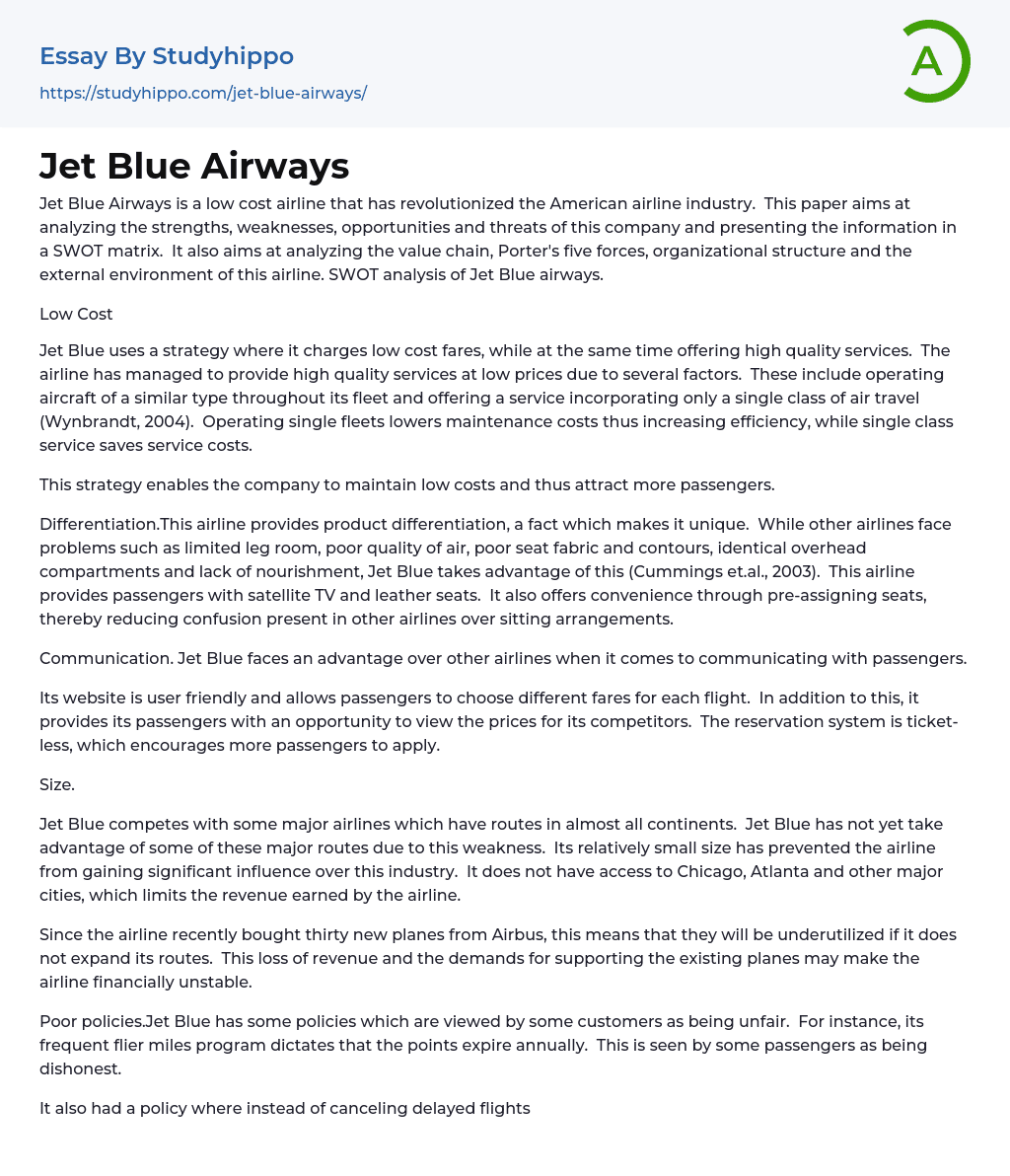Jet Blue Airways is a low cost airline that has revolutionized the American airline industry. This paper aims to analyze the strengths, weaknesses, opportunities, and threats of Jet Blue Airways and present the information in a SWOT matrix. It also aims to analyze the value chain, Porter's five forces, organizational structure, and the external environment of this airline. Additionally, it conducts a SWOT analysis of Jet Blue Airways.
Low Cost
Jet Blue utilizes a strategy where it offers low-cost fares while providing high-quality services. The airline achieves this by operating aircraft of a similar type throughout its fleet and offering only one class of air travel (Wynbrandt, 2004). Operating single fleets reduces maintenance costs and increases efficiency while offering single class service reduces service costs. This strategy allows the company to maintain low costs and attract more passengers.
Jet Blue stands out from
...other airlines by offering unique features and amenities. Instead of facing issues like limited leg room, poor air quality, uncomfortable seats, and lack of in-flight nourishment that are often experienced with other airlines, Jet Blue takes advantage of these challenges.
To enhance the flying experience for passengers, Jet Blue provides satellite TV and comfortable leather seats. It also improves convenience by allowing passengers to pre-assign seats, reducing confusion over seating arrangements commonly found on other airlines.
In terms of communication with its passengers, Jet Blue excels. Its website is user-friendly and enables passengers to select different fare options for each flight. Moreover, it allows passengers to compare prices with its competitors. The ticket-less reservation system motivates more passengers to choose Jet Blue for their flights.
Due to its relatively small size, Jet Blue competes with major airlines that
cover routes on nearly all continents. However, this weakness has hindered Jet Blue from capitalizing on these profitable routes. Without access to major cities like Chicago and Atlanta, the airline's revenue potential is limited. Although Jet Blue recently acquired thirty new planes from Airbus, they may not be fully utilized unless the airline expands its routes. This could lead to a loss of revenue and create financial instability as the airline will have to support the existing planes. Furthermore, some customers perceive Jet Blue's policies as unfair. For instance, their frequent flier miles program mandates points to expire annually, which is viewed as dishonest by certain passengers.
Jet Blue's decision to prioritize completing delayed flights rather than canceling them has had a negative impact on the airline's on-time performance compared to other major airlines. This has also affected the goodwill that Jet Blue had built over the years. However, Jet Blue has the potential to expand into regional and underserved markets, including emerging markets. Its successful application of its business model and established brand name make it well-suited for tapping into these untapped markets, resulting in increased profits. To achieve this goal more effectively, forming a strategic partnership with a profitable airline could be advantageous (Pearce and Robinson, 2005). The global rise in oil prices has significantly impacted the airline industry, which is one of the largest consumers of fuel. This poses a threat to Jet Blue's low-cost fare strategy due to its reputation. Sustaining low prices becomes challenging when faced with high oil prices, potentially causing customers to switch to competitors if substantial fare increases occur.
The airline industry faces challenges due to the threat of
new entrants, leading to increased competition among existing airlines and making it difficult for them to maintain profitability. The presence of more airlines in the market gives customers a wider selection, which forces airlines to cut costs in order to attract business. This cost-cutting negatively impacts profitability. To succeed in this competitive market, new airlines must find ways to differentiate themselves.
Another threat to airline profitability is the global economic meltdown. The current economic recession has resulted in decreased disposable incomes, causing fewer people to be able to afford air travel compared to other forms of transportation. Additionally, the economic meltdown has limited options for airlines to secure capital for expansion following the mortgage crisis. Consequently, the growth of the airline industry is being constrained.
Jet Blue's primary strategy is cost leadership, which involves producing goods or services at lower costs and targeting a large market (Peterson, 2004). They achieve this through cost reduction in operations and extensive distribution channels. Jet Blue also utilizes a single type of aircraft and offers ticket-less reservations and effective marketing techniques in order to increase their market share - all aligning with their cost leadership strategy.
In terms of value creation, Jet Blue provides additional benefits by offering satellite TV, leather seats, and more leg room on their flights as an added value for passengers.
Jet Blue's ability to distinguish itself from competitors and attract customers lies in its unique features, making it the preferred choice over other airlines.
- Auction essays
- Balanced Scorecard essays
- Business Plans essays
- Expense essays
- Income essays
- Net Income essays
- Security Guard essays
- Singapore Airlines essays
- Battle essays
- Intranet essays
- Maintenance essays
- Simulation essays
- Inn essays
- Chief Executive Officer essays
- Convenience Store essays
- Firm essays
- Training And Development essays
- Unilever essays
- Variable Cost essays
- Virgin Group essays
- Bargaining essays
- Entity essays
- Pest analysis essays
- Business Law essays
- Contract essays
- Consumer Protection essays
- Property essays
- Ownership essays
- Agreement essays
- Common Law essays
- Contract Law essays
- Justice essays
- Security essays
- Tort Law essays
- United States Constitution essays
- Crime essays
- Lawsuit essays
- Treaty essays
- Family Law essays
- Marijuana Legalization essays
- Constitution essays
- War on Drugs essays
- Court essays
- Jury essays
- Police essays
- Protection essays
- Community Policing essays
- Criminal Law essays
- Judge essays
- Lawyer essays




